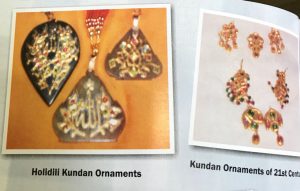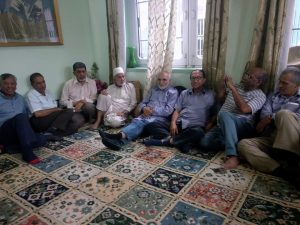Peace Watch » Kashmir-Talk » The Ward Four Boys Rendezvous With A Legendary Craftsman
The Ward Four Boys Rendezvous With A Legendary Craftsman
Nostalgia
ZGM
Stories of many of the ward four boys, like other downtown Srinagar boys, are strewn across the countries, yet their loyalty is etched to the maze of narrow streets, lanes and by-lanes they grew up in and played games; hide and seek, hopscotch and tip-cat. Hitched to their roots, on a mere mention of their birth burg reminiscence cascade like high mountain brooks and pilot them down the memory lane, and every prank and play remembered brightens even their ‘autumn rusted’ faces. This I realized, when a childhood friend had organized a unique get-together of friends to rejoice a golden occasion, the craftsmanship of his father, who at 93, is as nimble-fingered as he was in teens and able to use assortment of mini chisels and tiny ball-peen hammers as dextrously, as many of us had seen him doing during our days in Jabari-Chatahal– Government Middle School Daribal in the fifties and early sixties.
Haji Mohammad Amin Kundanagar, father of our friend Professor. Mohammad Rashid-ud-Din Kundanagar had a few days back inscribed kalma taiba on one side and a Persian verse with the date on another side of a specially made gold coin with his tiny tools. I have been one amongst the hundreds of students of the Middle School, who have seen young astrakhan capped Amin Sahib and turbaned Maqbool Hussain, his elder working in the ground floor of their house. Like Santoor players, with their necks bending playing with agility on the mini-tools they were creating marvels on gold and silver plaques and ornaments.
Those invited to share experiences of the veteran craftsman, artists and ace calligraphist on the festive occasion were Dr. Abdul Wahid, Dr. Bashir Ahmad Makdoomi, Dr. Mohammad Ashraf Jallu and Mohammad Saleem Beg, friends who had served in different countries and were widely traveled. Incidentally, all those invited were from the ward four- the home of thousands of great artisans, artists, men of letters, the quintessence of the social ethos of the land and nerve center of the resistance. Despite, some of them having served for donkeys’ years in the deserts of Arabia and cities of Europe, their moorings are as strongly anchored in the land of their birth as roots of majestic Chinars in the soil. None of them crowed about their foreign sojourns, talking to Amin Sahib, everyone turned nostalgic about their childhood, when waters of the Dal Lake were as pristine as virgin highland tarns, the city for its serpentine waterways continued to be known as the Venice of the East and the it was dotted with artisan’s homes like the historical Kundanagar House of Khawaja Bazar- where deft hand fashioned artefacts that continue to be the prized possession of Museums as famous as the Salar Jung Museum of Hyderabad.
The Kundanagar house, unlike many other houses of artisans of repute, is of great significance. It has been a mute spectator to rise of the resistance movement, and some of the important decisions that have shaped the contemporary history were taken in the Kani (hall) of the house overlooking the martyr’s graveyard. For about six years, till the construction on the Mujahid Manzil, the house practically worked as headquarters of the Muslim Conference. In 1931, when the movement started Amin Sahib, was six or seven years old. He, in fact, is a close witness to the Kashmir struggle against the autocratic rule and the faux pas’ of the leadership- and remembers how some members in the Kundanagar House had raised their voice against some decision of leaders for which people had, later on, to pay huge prices.
Like many artisan Mohammad Baba, the forefather of the Kundanagar family was also part of Shah-i-Hamadan’s caravan. Nonetheless, about Kundan, the art of engraving and embellishing gold and silver ornaments with precious stone, the family has an interesting story to tell.
The art did not arrive into Kashmir from Persia or Central Asia, but it was Sikh devotee visiting Khanaqah-I- Shah-i-Hamadan, who imparted the art to one of the family ancestors Hakeem, who passed on the art to his son Nizam-u-Din. It passed on from generation to generation till it reached Khawaja Ghulam Mohammad Kundanagar, known in history as Mama Saab Kundanagar- he and his sons perfected the art. In Kashmir, the Kundan-Jewellery besides the royal families was much sought after by rich and elite- wearing this jewelry was a status symbol. The art has now almost died, and perhaps Haji Mohammad Amin is the only living artisan of this craft.
The historical heritage house of the Kundanagar family is no more with them, nevertheless it needs to be preserved.
Filed under: Kashmir-Talk








